











DRS4DNXTDRS6ANXT


You’re looking at it! Furuno’s award-winning Radar gives you clarity & target separation like no one else. Don’t take our word for it. See for yourself. Scan here, and we’ll show you!



























Do you love boating? Then you know how fun and relaxing it can be on the open water. But you also know that things can go wrong sometimes, like storms, accidents, theft, or injuries. That’s why boat insurance is so important. Here are some reasons why.
• Boat insurance can help you pay for damage to your boat, or to other boats or docks, up to specifed limits.
• If you borrowed money to buy your boat, your lender may require insurance. And if you want to explore different places, some marinas or waterways may ask you to show proof of insurance.
Progressive Casualty Ins. Co. and af fliates Coverages subject to policy terms and conditions.
• Boat insurance can also come in handy if you need an on-water tow, jump start, or fuel delivery with optional Sign & Glide® coverage. And if your boat sinks, boat insurance can pay for the cost of removing it from the water (if removal is legally required).
Get boat insurance from Progressive and enjoy the peace of mind that comes with it.
Scan to get a quote in as little as 4 minutes
Go to progressive.com to learn more.
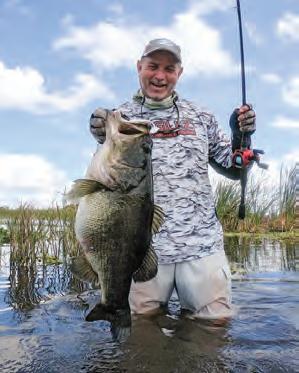

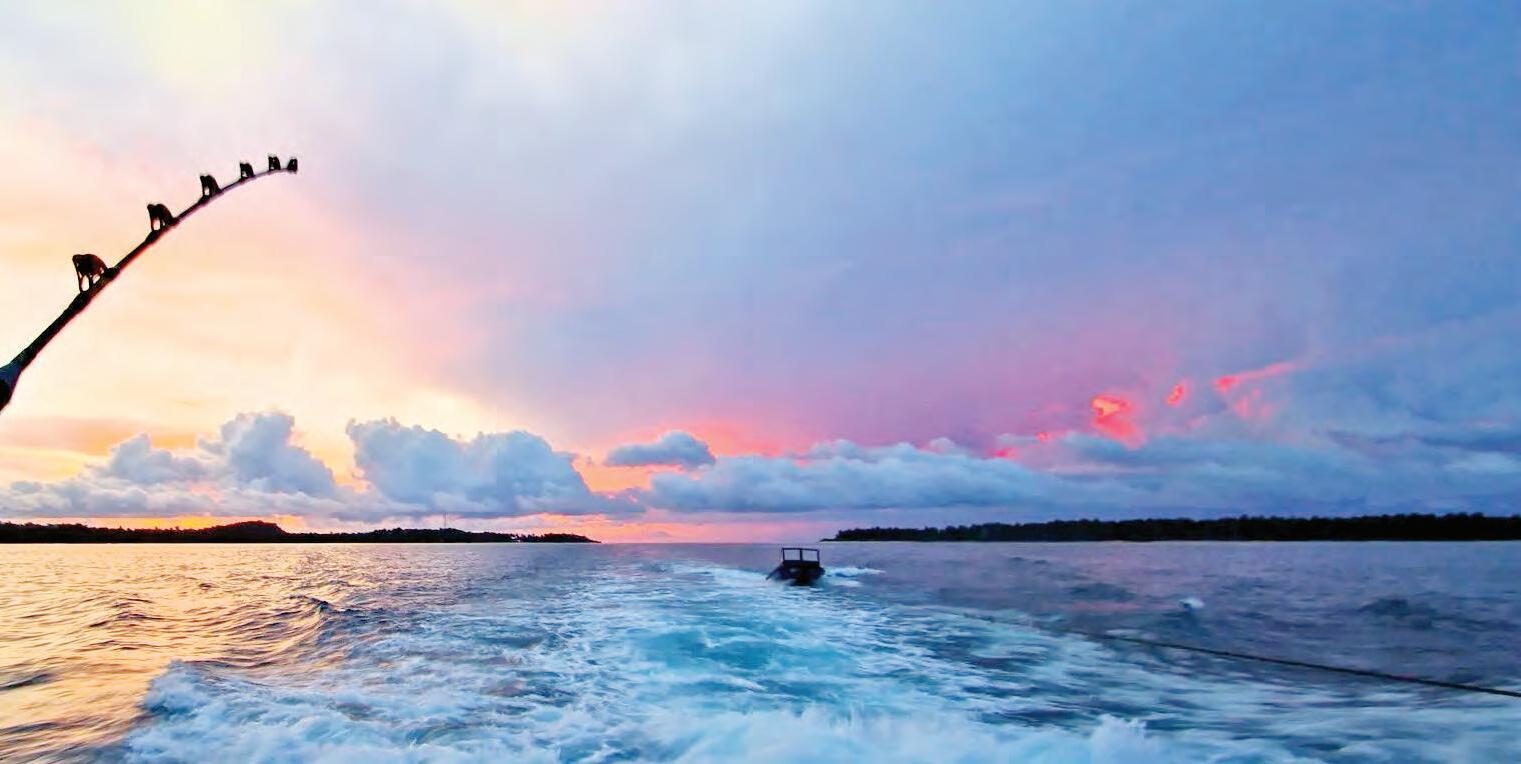


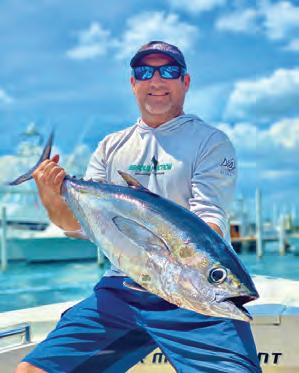





















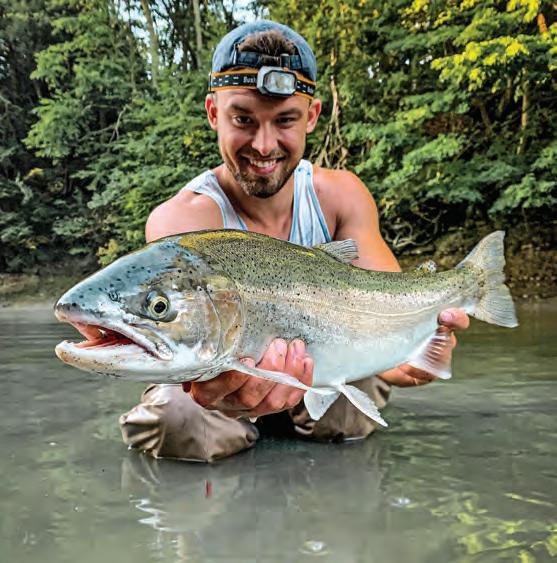
Trout don’t grow huge on a diet of insects alone, so Budkey fshes 2- to 3-inch-long bait lures to take advantage of the carnivorous tendencies of big fsh. Tese fsh have good eyesight, so he fshes 4-pound-test and said light line can be the diference between catching dozens of fsh or nothing at all.
Now… battling 10-pound trout in current with light line is tricky, to say the least.
“You really have to wear them out. you all the way down the creek and back up it, jumping and thrashing,” Budkey said. “If you try to muscle them, they’ll break you o

Part-time guide Stephen Budkey catches a lot of outsized trout fshing the streams of western Pennsylvania. Much of his success with giant 6- to 15-pound rainbows and browns has to do with location, but he also uses some interesting tactics that specifcally appeal to large fsh.
Te setting is on Lake Erie tributaries. Tese streams vary in size, but generally Pennsylvania is known for smaller fows. Te key to their productivity is the lake. Lake Erie feeder streams experience steelhead runs a lot like the rivers of the Pacifc Northwest. Fish grow large gorging on baitfsh in open water before pushing into tributaries in early fall to spawn. Te lakerun rainbow trout in this migration are called steelheads, and there are bruiser brown trout that run up out of the lake, as well. Budkey also has access to a stretch of privately managed tailwater, which is an obvious target-rich environment for very large trout. Regardless of where he’s fshing, he uses tactics and gear that might seem odd to
trout anglers in other regions.
If you’re a snooty fy fsher, set your tweed hat aside for a minute. Tis might not convince you to pick up a spinning rod, but Budkey has an undeniable knack for catching giant trout, and you might just learn or adapt something from his style of fshing.
Reading water in western Pennsylvania is the same as it is anywhere. Trout like the cold, welloxygenated water of broken water and rifes. When targeting large trout, Budkey said he looks for the deepest runs or waterfall holes in the creek he’s fshing.
“I’m talking about creeks that are sometimes just the width of your car, and these fsh will just stack up in there,” he said. “And when they stack up, they really stack up. It’s wild.”
Budkey said clients who are decent anglers can have 25-fsh days that include trout that might weigh 6 to 10 pounds. Most of these trout were originally stocked by the state, but there is some reproduction, and holdover fsh that have been in
To even the odds, Budkey fshes a 10-footlong noodle rod, which is extremely absorb shock during the fght and protect that light line. Another important factor is a big net for landing fsh, and it doesn’t hurt to have someone else to serve as net-man. Sometimes it’s not possible to bring big fsh to hand, and a net man can wade out to get them.
When trout are aggressive, they are super aggressive, Budkey said. He likes a good-old foating Rapala when the trout are actively chasing and fshes a 2-inch F05 or a 2.75-inch F07 tied on with a loop knot. He just throws it into the current, gives it a jerk to get it wobbling and lets it sit there until a fsh crashes it.

If fsh want something on or near the bottom, Budkey fshes jigs. Trout Magnet jigheads in 1/32 and 1/64 ounce—the lightest you can get away with—paired with Gulp! sof plastics are deadly. Trout are suckers for these scented plastics, and he likes the 2.5- and 3-inch minnows as well as Killer Crawlers and Pinched Crawlers.
Te technique with the jigs is slow. Budkey said he just wiggles the rod tip to give the lure some action.
“It’s almost like I don’t want to move the jig toward me very much, at all. I just want it to sit there and wiggle,” he said. “It’s like shaking a donut in someone’s face at the gym. Tey can’t handle it. Tey’ll run out and grab it.”
Afer the take, it’s time to start worrying about how to battle that fsh to the net on super-light line. Budkey said that is the most fun part of trout fshing, and he loves nothing more than showing other people how to experience it.
See some of Budkey’s tactics on YouTube @FishFightsPA.







In mid-June, NOAA Fisheries announced a one-day recreational season for red snapper in the South Atlantic. Although there was widespread grumbling and gnashing of teeth by recreational anglers, it did not come as a surprise to pretty much anyone.
First the season: Red snapper harvest will be open for recreational anglers in the South Atlantic, from North Carolina through Florida, on July 12. Te limit is one fsh per angler.
Te date is subject to change in case a small craf weather advisory is projected. Any change in the date of the recreational season will be announced in the Federal Register, Fishery Bulletin, and an announcement via NOAA Weather Radio.
Now the reasoning: In 2008, NOAA’s stock assessment indicated red snapper in the South Atlantic were in bad shape and devastatingly overfshed. Over the last 16 years, NOAA has essentially shut down recreational fshing for the species, and catch limits for commercial fshing have been kept very low. Not surprisingly, it worked! Populations rebounded to the point where data indicates red snapper are now more plentiful in the South Atlantic than at any time since such data existed. What’s more, the fshery continues to improve ahead of the projected recovery timeline.
Tis year, instead of allowing greater access to the fshery, NOAA decided to tighten already draconian restrictions. Te overall quota for red snapper was cut by 25 percent for 2024. As the fshery has improved, recreational anglers have gone from a ridiculously short fve-day season in 2019 to an absurd one day of fshing in 2024.
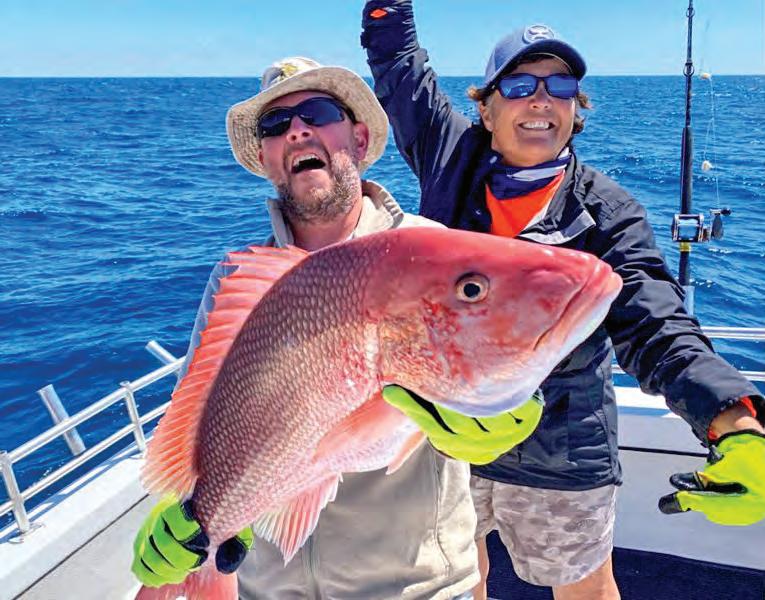
According to NOAA Fisheries, the red snapper fshery is in a “recovery trap.” Abundant red snapper have led to increased incidental catches by anglers, and NOAA extrapolates that data into a formula for catch-and-release mortality. Basically, they’re telling us that there are so many red snapper that anglers are killing too many of them by catching and releasing them.
Te result is tighter regulations in an infexible system, where highly questionable data is used to shut down access to a public resource. We’re not even going into numerous occasions in recent years when NOAA has been forced to admit its data is shockingly fawed.
According to the American Sportfshing Association, work is underway to improve data collection for the South Atlantic red snapper fshery.
In the meantime, try not to get in a boat wreck during the one-day mad dash to catch your one red snapper from the Atlantic. Or you can just trailer your boat to the Gulf of Mexico, where the states fnally managed to bludgeon some sense into federal fsheries managers a few years ago.
For more information, go to coastalanglermag.com.














Not only are these hefty bars one full Troy ounce of real, .999 precious silver, they’re also beautiful, featuring the crisp image of a Morgan Silver Dollar struck onto the surface. That collectible image adds interest and makes these Silver Bars even more desirable. Minted in the U.S.A. from shimmering American silver, these one-ounce 99.9% fine silver bars are a great alternative to one-ounce silver coins or rounds. Plus, they offer great savings compared to other bullion options like one-ounce sovereign silver coins. Take advantage of our special offer for new customers only and save $10.00 off our regular prices.
What makes them iconic? The Morgan Silver Dollar is the legendary coin that built the Wild West. It exemplifies the American spirit like few other coins, and was created using silver mined from the famous Comstock Lode in Nevada. In fact, when travelers approached the mountains around the boomtown of Virginia City, Nevada in the 1850s, they were startled to see the hills shining in the sunlight like a mirror. A mirage caused by weary eyes?





No, rather the effect came from tiny flecks of silver glinting in the sun.






While no one can predict the future value of silver in an uncertain economy, many Americans are rushing to get their hands on as much silver as possible, putting it away for themselves and their loved ones. You’ll enjoy owning these Silver Bars. They’re tangible. They feel good when you hold them, You’ll relish the design and thinking about all it represents.
These Morgan Design One-Ounce Bars make appreciated gifts for birthdays, anniversaries and graduations, creating a legacy sure to be cherished for a lifetime.
Order More and SAVE
You can save $10.00 off our regular price when you buy now. There is a limit of 25 Bars per customer, which means with this special offer, you can save up to $250.
Hurry. Secure Yours Now! Call right now to secure your .999 fine silver Morgan Design One-Ounce Silver Bars. You’ll be glad you did.
One-Ounce Silver Morgan Design Bar
$49.95 ea.
Special ofer - $39.95 ea. +s/h
SAVE $10 - $250
Limit of 25 bars per customer

SHIPPING over $99!
time only. Product total over $99
Welcome to the best day of the week—the day before your next fshing trip! If you’re going ofshore tomorrow, it’s time to make a game plan, and a look at current Sea Surface Temperature (SST) charts is the frst step. With knowledge of accurate surface temps, chlorophyll imagery and other environmental factors, you can home in on areas that are likely to hold baitfsh and feeding predators.
By Mark Ambertto consider when targeting gamefsh. It provides shelter and feeding opportunities for all marine life. While you can stumble upon fsh just about anywhere in the ocean, you’ll locate more on and around structure.
Large underwater structure defects current and pushes nutrient-rich water toward the surface, creating areas where bait concentrates and holds. Also remember that weed lines are a key form of structure on the edges of the Gulf Stream.

A reasonably priced satellite service is a small price to pay when compared to rising fuel prices and time spent running in search of gamefsh. Here are a few of the factors SST charts can help you decipher and improve the odds of fnding fsh.
Color Breaks: Te boundary areas between blue and green water, ofen referred to as color breaks, will typically stack up bait and hold above-average numbers of gamefsh.
Chlorophyll is the beginning of the food chain for marine life. Find it and you have a good chance at locating bait and fsh. Temperature and chlorophyll breaks ofen correspond with color changes. So, once you’ve reviewed the images and located the general area of a color break, this becomes an area of interest.
Structure & Current: Structure is critical
If you can fnd a color change that corresponds with structure, this is where you want to begin fshing. If everything lines up, there’s a good chance upon arrival that you’ll see marine life including birds, porpoise, fying fsh and other bait. Tis doesn’t mean you won’t catch fsh in of-colored water, but there’s a much better chance you’ll fnd concentrations of bait in or around the edges of areas where green and blue water interact.
Tides from inlets also play a role in water clarity, creating rips and weed-line formation. Bait will concentrate along the edge, especially where this water pushes up against the waters of the Gulf Stream. Look for these demarcation lines on incoming and outgoing tides.
Learn to read these vital signs both on and of the water using charts. If you can consistently

fnd areas that hold bait, you’ll always have a shot at your quarry. You will have become a top predator!
Mark Ambert, IG @marksgonefshing_™

There’s no better place to connect with nature and camp in the forest and under the stars than Tennessee State Parks. Camping is one of the most popular recreational activities in Tennessee which has 56 beautiful parks and over 3000 campsites.
Tennessee is one of only seven states with no access fee's to the 56 parks so if you just want to enjoy a ride through the park and take in the view or get out for a hike it doesn't cost anything. There are many additional activities that provide a fee to participate.
Tennessee State Parks have numerous activities from birding, biking, camping, fishing, golfing, boating, swimming, mountain biking, hiking, caving, and horseback riding. There's always a monthly calendar of group related activities. Many programs are offered to teens and children such as the Junior Rangers and various summer activities for kids out of school. So, check it out.
The views can be spectacular in an RV or with simple tent camping. Reservations can be made for your room, cabin or campsite. Vacation packages are available to participate in the history of the park or its local flora and fauna. Also, group events can be made for weddings, conference meetings and family reunions. Reservations can be made one year in advance. Check out all of what Tennessee State Parks have to offer. A really nice brochure can be picked up at the Tennessee
Travel Center Rest Stops along the interstate highways or printed out on the website. For more information, check out the website at tnstateparks.com
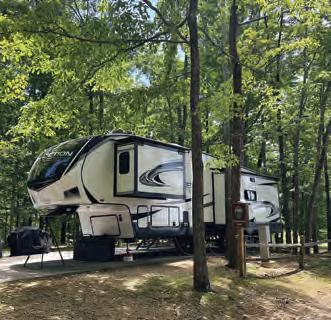





Whenthe summer rains come and its that drizzly day, most anglers might not want to get out of a cozy house. But, these weather conditions can turn into a day for many anglers to remember. Proper rain gear can keep the angler dry and cozy and ready for the action. Summer time buzz baiting has proven very effective on these rain and overcast early mornings.
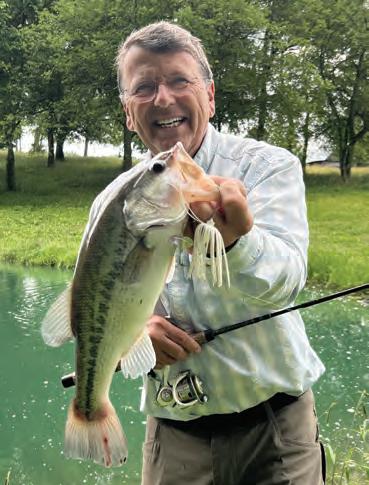
Largemouth bass are natural ambush predators and the sound and annoyance of a buzz bait can trigger the predator’s natural instinct to eat it or just plain kill the intruder. There is nothing more exciting to see a largemouth or any fish species blow up on a top water bait and the fast action of buzz baiting for bass is no exception.
Early summer mornings and late afternoon can be the most effective time to use a buzz bait in the hot summer months but rain and overcast days can be productive throughout the day. The cooler rain supplies increased oxygen to the water and this can trigger the fish to feed or be on the prowl for an easy meal.
Many styles of buzz baits can be purchased and every angler has his brand and lure of choice. A white buzz bait is the most popular color for many anglers but black can be the go to color as well. Darker colors create a shadow look on the surface and bass can be less spooky to strike it. They may not be exactly sure what it is on the surface making this loud clatter and buzzing noise so they attack from a predator mode. So the next time you get that rainy day just tie on a buzz bait for some hot summer time action and enjoy the great outdoors.

The information provided is for a new lake or pond or a newly renovated lake or pond with no fish present. If your lake or pond has filled with water and is holding water at this point you are ready to stock it with fish. This step is critical as probably 70% of lakes and ponds are stocked incorrectly with little understanding of what it takes to build a healthy balanced fish population. There have been millions of dollars spent in university research on how to stock lakes and ponds correctly. The advice provided will come from that research. Keep in mind this information is based primarily in the Southeast of the United States but information in your part of the country or world can be easily obtained by contacting local university fisheries professors or your government Wildlife and Fisheries Departments in your area.
There are many unscrupulous fish growers and dealers who will sell you anything and everything as long as you have the money to pay for it. Most have no education in the field. I highly recommend you seek out a professional fisheries biologist who will give you the proper advice and do your homework and research that information as well. You can easily ruin the lake or pond by incorrect stocking and start your lake or pond off already needing a corrective stocking because of the mistakes you made by following improper advice.
Remember, previously I stated 70% of the lakes and ponds that I see annually were stocked incorrectly and are now out of balance This is the professional terminology in lake or ponds whether the fish population is in balance or out of balance. Out of balance fish populations result in poor fishing and stunted small fishes. A corrective stocking must be made and sometimes it takes years to get the lake or pond back in balance or it must be drained and start over. Many lakes and ponds require corrective stockings because they were improperly stocked and I will address this in another chapter on how to solve these problems. Point being, do your homework on the front end so you don't have these expensive issues to correct.
The most common stocking in lakes and ponds in the Southeast are bluegill, redear, fathead minnows and largemouth bass. There is a process of how to stock correctly. You will want to stock your forage fishes (bluegill, redear and fatheads) first and let them spawn then wait a few months and then stock the predator fish (bass). The forage fishes are the fish that provide most of the food for the pond. The bluegill and fathead minnows spawn several times per year. This is what provides the food for the lake or pond and builds the food chain to provide a healthy lake or pond so as the fish grow to their maximum lengths and weights. Research has shown you need five bluegill for every one bass so a lake or pond will remain in balance.
The reason we stock the forage fish first is we want the bluegill and fatheads to spawn then we introduce the bass fingerlings. The bass fingerlings will feed on the offspring of our original bluegill and fatheads as they will be too big for the bass fingerlings to eat. Thus, we have our original brood stock of bluegill and fatheads protected for our future fishes to spawn and build the food chain. Never stock your bass fingerlings at the same time as you stock your bluegill and minnows. Throwing in large bass caught from other places is a dagger in the back to start your lake or pond off correctly. They will gobble up our initial small bluegill and fatheads which destroys the ability to build the food chain properly.
Stocking rates in the Southeast are 500 bluegill/acre, 125 redear/acre

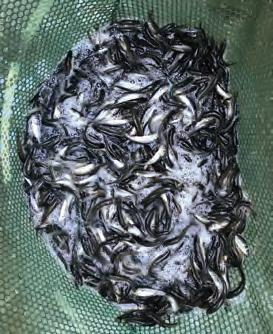
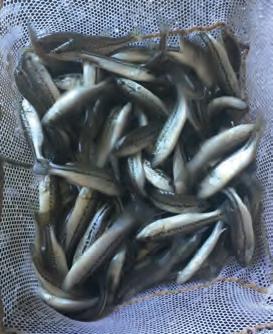

and 10 pounds of fathead/acre. Adjust the stocking rate based on the size of your lake or pond. Once these fishes have spawned, 100 largemouth bass/acre are stocked. Other fish combinations such as bluegill and catfish combinations can be stocked but always consult a qualified Fisheries Biologist to make of the correct numbers so your lake or pond will be in balance with the predator and prey combinations. Crappie should never be stocked in small impoundments less than 15 acres as they reproduce too heavy and over-take a small lake or pond and this normally results in a stunted fishery.
Contact David McGavock at Small Waters 615.977.0752 for any questions regarding your lake or pond.




NEW MOON
JULY 5, 2024
FULL MOON
JULY 21, 2023


Manyoutdoor enthusiast will take an adventure in July for a paddle and float on their favorite waters. Kayaking and canoeing have long been a popular recreational activity in Tennessee and Alabama public waters.

I recently did an interview with a long standing business that rents and supplies kayaks and canoes for those who want to paddle and float the scenic Duck River. River Rat's Canoe Rental located in Columbia, Tennessee supplies both kayaks and canoes to the public and has an awesome Staff. This second generation family owned company by William Stewart has been in business for 45 years. Wow, 45 years! Manager's Matt Runions and Stephen Dalton have both been with the company for a decade are very knowledgeable and experienced on the Duck.
Kayaking is one of the fastest growing activities in water recreation. "Kayaking and canoeing brings the whole family together for a very special day," says Runions. "Two floats are available and the most popular is a 5 mile canoe or kayak paddle which the customer is dropped off and pick up by River Rat's Staff." This is normally a 2 to 4 hour paddle and float trip. So, plan accordingly. The other is a craze called Tubing. A 1.5 mile Tubing float is also available.
"This popular actitivity from Memorial to Labor Day is a great way to enjoy nature such as wildlife, birds, turtles and even an occasional bald eagle sighting," says Dalton. "The Duck River is well known for it's many species of wildlife and aquatic life and a great way to bring friends and family together."
River Rat's Canoe Rental is located at 4361 Highway 431, Columbia, Tennessee on the scenic Duck River. They can be reached at 931-381-2278 and bookings can be made on their website at riverratcanoe.com

HybridBluegill have been the center of much controversy since the 1980’s. A cross between a green sunfish and bluegill. They were popular to stock in private lakes and ponds. The first cross would grow rapidly and it was common to see them reach 1 to 2 pound in weight. Many lakes and ponds with feed programs reported 2 to even 3 pound in growth in a few years. Pictures would circulate around about these huge panfish called hybrid bluegill.
The problem was 70% of the offspring would revert back to green sunfish. A trash fish that is known as an undesirable species to have in lakes and ponds. They are voracious bass and bluegill egg eaters and would quickly overpopulate and take over the pond. Once they eat up all the desirable forage, they have nothing to eat and become stunted in a few years. I’ve seen this scenario thousands of times over my years as a fisheries professional. If you want to stock hybrid bluegill be prepared to drain the lake or pond every 5 to 7 years and restock and start over.
The most common problem in lakes and ponds a few years after being stocked with hybrid bluegill is the lack of bass reproduction. The hybrid bluegill spawns numerous times during the summer and fall months creating thousands. They are


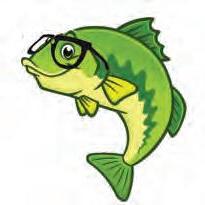

very aggressive to eat bass eggs, bass fry and bass fingerlings. The lake or pond owner notices after a couple of years very few new young of year bass are being caught. A lake or pond needs the predator bass to keep the bluegill population in check. It’s a very common problem when population net samples are made to find hundreds of small green sunfish yet the lack of presence in bass fingerlings. Your future predator that keeps the lake or pond in balance. Avoid this common mistake and do not stock hybrid bluegill in your lake or pond.
David McGavock is a Certified Fisheries Biologist. If you have questions about your lake or pond call 615-977-0752.

Once a year on the first Saturday in June, the National Free Fishing Day is held. No fishing license is required and many Tennessee counties and cities hold sponsored fishing events for the kids and families. The Tennessee Wildlife Resources Agency (TWRA) stocks 1000’s of pounds of fish to add a little kick to the potential successful catch.
TWRA has provided the annual free fishing opportunity in hopes of introducing children and families to fishing and outdoor recreation. Each year, the agency stocks fish across the state to ensure high-quality and exciting fishing for participants.
Much time and effort by the TWRA is put into these events held statewide to be a success. Private companies and

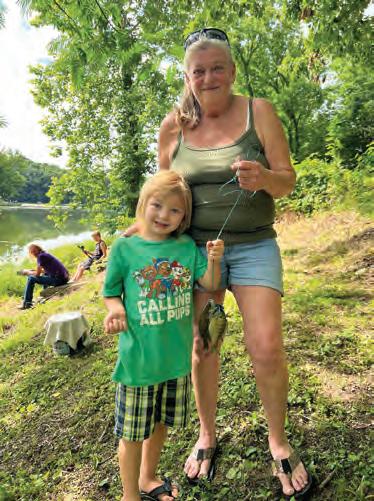
organizations help by donating time and monies for gifts, prizes, food and cooking for a free lunch to the participants.
New Lake, located in Lewisburg, Tennessee had a very successful event. TWRA Marshall County Wildlife Officer Mark Ventura led the event along with support from Aaron Burch from TWRA’s Normandy Fisheries. “Any way we can get kids back into the outdoors is a positive thing,”says Wildlife Officer Mark Ventura. “Bringing families together into outdoor activities is the goal.”
For many who enjoy fishing, it’s all about fishing and the total experience. Many fish from the bank and even some bring a boat to enjoy the event. “The reaction of a kid catching a fish is



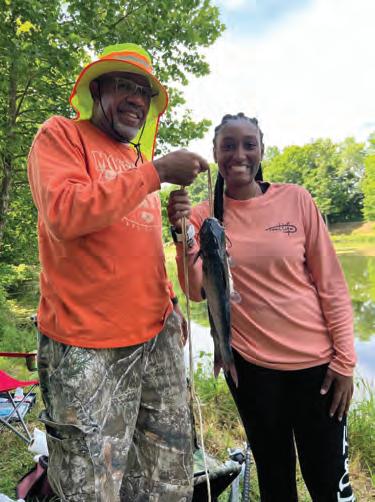
a great experience to witness,” says Normandy Fisheries Aaron Burch. Burch continued, “For some it is the first opportunity to even try fishing for the first time.”
The event’s private sponsor was WoodmenLife. WoodmenLife supports communities through many local volunteer activities for hundreds of causes. They donated their time and funds to cooking a very well organized and prepared lunch. WoodmenLife gave away prizes and the big finale was the 50 inch TV drawing. Brad Jones, Local WoodmenLife representative said, “WoodmenLife is not just another insurance company as we are a fraternal organization that gives back to the community.” Numerous WoodmenLife volunteers


were at the event and pledged their time and effort to support the event. Special thanks to WoodmenLife and to Frito Lay Fayetteville and Pulaski for preparing and providing lunch refreshments.
Several nice stringers and baskets of fish were caught and even a prize was given for the biggest fish. Emma Thompson was the winner of the Big Fish prize.
After lunch, the finale came at the end with the TWRA ticket drawing of prizes which every kid who attended walked away with a prize or gift bag supplied by the TWRA. Special thanks to the TWRA and WoodmenLife for putting on such a special event for the community!


The one inch Slider grub has long been known for it’s success in catching many species of panfish. Available in numerous colors, it’s action in the water has proven to be very enticing to catch a fish. The pearl color model #CBP3 has been the most popular as it mimics a natural small shad fingerling found in many lakes, rivers and streams.
Rigged with a Slider ball 1/32 oz jig-head which comes in several colors. Black is the most popular jighead color while red or chartreuse can be good in murky waters. A slow retrieve is best and wait for the thump then set the hook. In addition, using a jig style weighted float can be very effective. A little trial and error is needed to find the proper depth on any given time of year but once dialed in it can produce a very good day on the water.
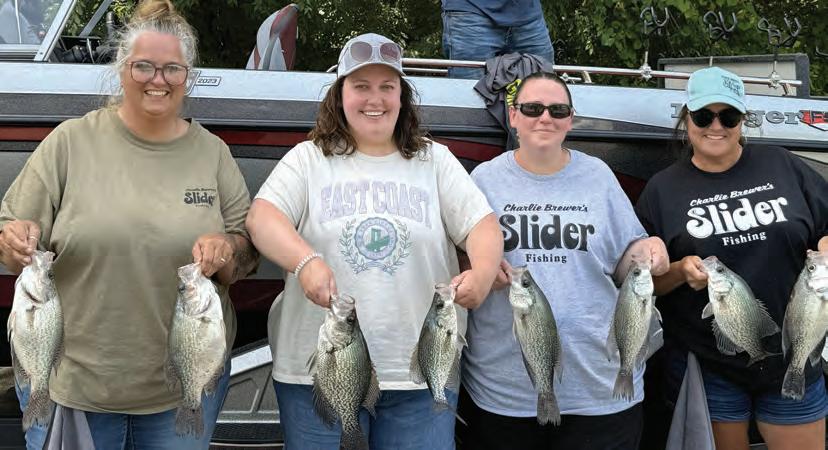
The one inch Slider grub has always been a go too bait for many anglers around the crappie pre-spawn, spawn, and post spawn but the lure has proven consistent any time of year if the angler understands how to get the bait at the proper depth where the fish are located. As hotter summer months are approaching, trolling the Slider grub has proven very effective for crappie once the spawn is over and crappie return to the deeper waters. Vary the troll speed to find the right depths and once a fish is caught drop a marker buoy and troll over the same area back and forth as many times as a school has been located and the angler can easily catch his limit in one good location.
Another popular lure developed by Charlie Brewer is the Charlie Bee and has become legend with many anglers. The one inch grub and a small spinner blade was added to the setup. Available in numerous colors and very versatile with a slow cast and retrieve technique is deadly on many species of fish. Over the years, the Charlie Bee has proven to fill many live wells, baskets and stringers with a nice day’s catch on the water.
If you would like to try any of these legendary baits contact the Slider Fishing Team at 1.800.762.4701. A very friendly and
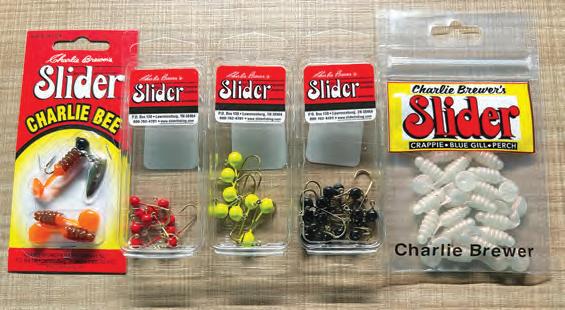
knowledgeable Staff can guide you on the most popular choices and colors to complete your order. Website orders are also available at sliderfishing.com.


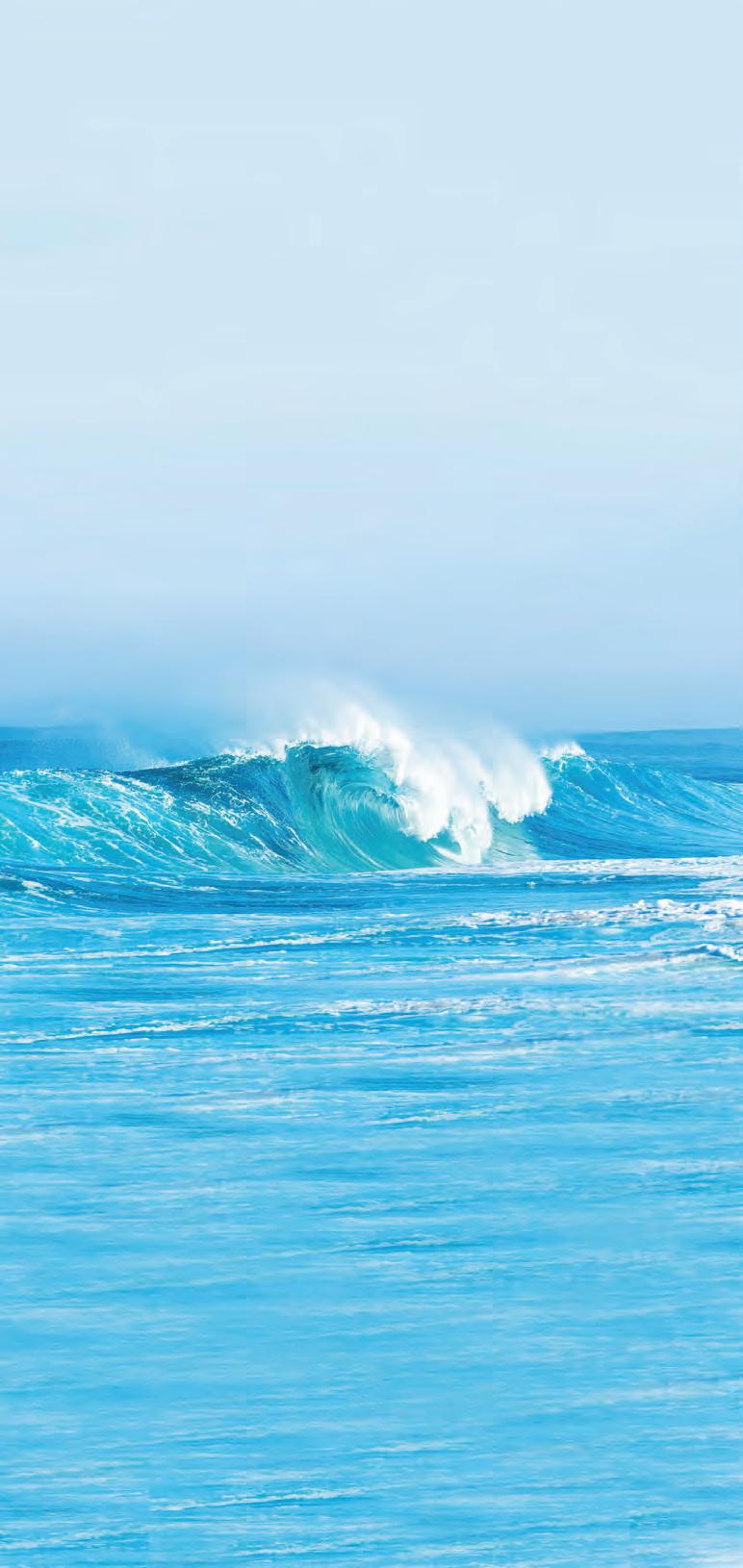


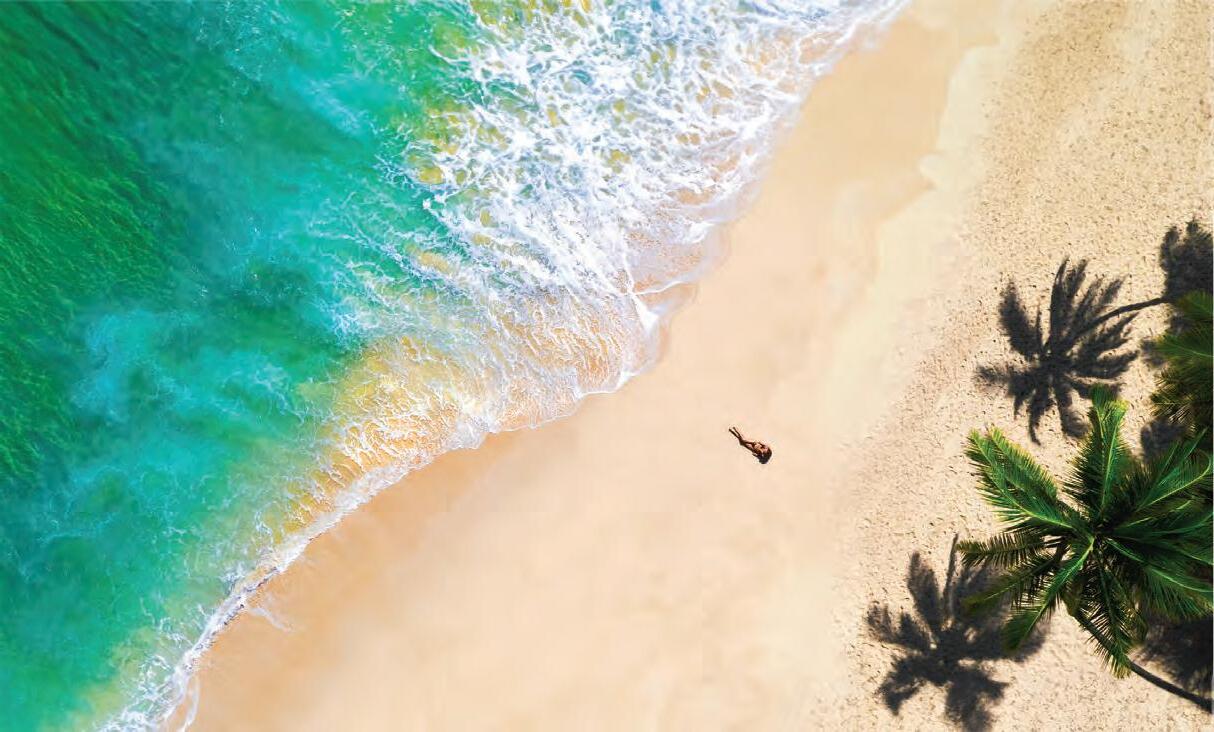
For the past two years, I’ve had the pleasure of taking Coastal Conservation Association’s Leiza Fitzgerald out on the water to assist in tagging dolphinfsh for the CCA STAR competition. As if going fshing wasn’t enough of a prize, recreational anglers can sign up for this competition, with a donation to a good cause, and participate in this fshing side quest for all sorts of epic prizes.
Tagging trips with Leiza are some of my favorite mahi trips. She is more excited about catching throw-backs than anything we put in the box. Each undersized mahi, and most of the keepers, are handled with care and released with some fancy new jewelry.
With her tagging gun locked and loaded and a towel to lay over the fsh’s eyes to calm them, Leiza carefully and quickly turns peanuts into prizes, and sends them on their way.
CCA Florida STAR presented by Yamaha is a summer-long event that invites anglers and non-anglers to participate and win prizes valued at almost $500,000, including boats, motors, scholarships and more. Te competition is currently live, and registration is open until Sept. 2.
“In the past nine years, it’s been amazing to see STAR participants support conservation and embrace the catch-photo format,” Fitzgerald
said. “Awarding nearly $4 million in prizes, with $900,000 specifcally awarded in youth scholarships to the thousands of statewide STAR registrants is exciting, but even more exciting is the awareness STAR has created for the conservation of our marine fsheries.”
Te 2024 STAR competition is comprised of eight divisions targeting inshore and ofshore species along with trash cleanup. Wherever your home waters are, there is a way to get involved.
Te most notable of the STAR competitions is for tagged redfsh. Te best opportunity to catch this year’s tagged redfsh will be in Citrus and Charlotte counties, STAR’s 2024 Destination Counties, which each have eight tagged redfsh in their coastal waters.

Six years ago, STAR initiated a tagged fsh division for ofshore anglers, the Tigress Outriggers and Gear Tagged Dolphin Division. Tis division ofers one winner a $10,000 cash prize or scholarship. Te frst STAR registrant who catches a STAR tagged dolphin wins.

Te tagged dolphinfsh were caught and released of the Florida Keys. Tese fsh will migrate up the east and west coasts, providing anglers a shot at recapturing one. Tere have only been two tagged dolphin recaptured in six years, and neither angler was registered in the competition. You have to be in it to win it!
Make sure to report any tagged fsh you catch, whether you are registered or not. Take photos, measurements, tag numbers and information, and note the location of recapture. You do not need to remove the tag if you are releasing the fsh.
Fish are very mysterious, and there is so much we don’t know about them. Te more data we collect, the better conservation we can provide.
Capt. Quinlyn Haddon; Sweet E’nuf Charters, Marathon, Florida Keys; @captainquinlyn; captainquinlyn.com; (504) 920-6342.
- $80 Entry (includes one year CCA membership)
- $40 Entry for current CCA members
- FREE for Youth
- Over 100 Days of Fishing
- $500,000 in Prizes & Scholarships
- Memorial Day Weekend to Labor Day








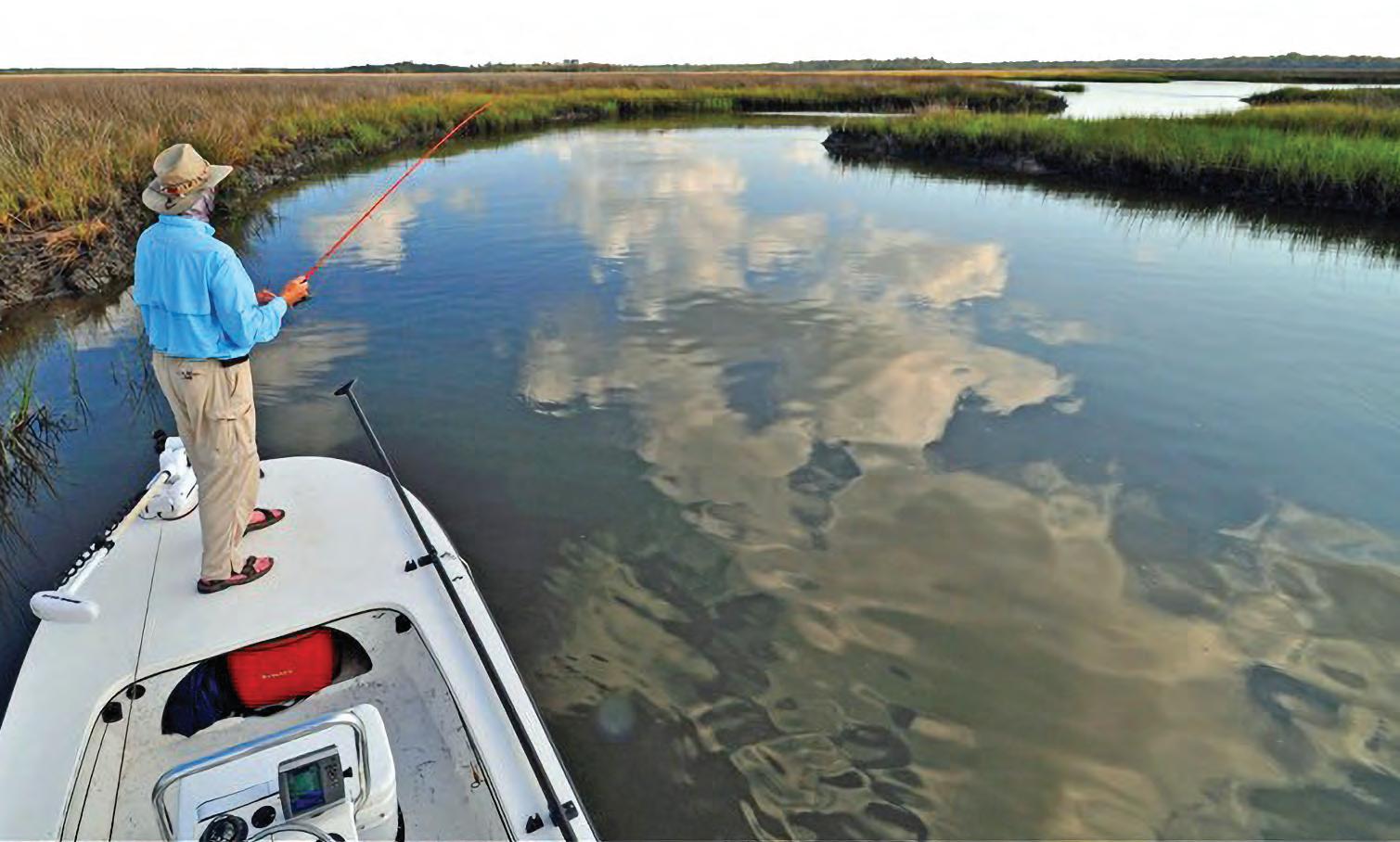

Fishing during the hot stale days of summer is ofen thought to be the toughest and slowest fshing there is. I am here to help with that.
Not only are the next few months an amazing time to catch fsh, they can also be the easiest time to pin-point patterns for big bass. Spawning bluegills are the key. Bass will set up around bluegill beds and feed heavily on an easy meal of bluegills that congregate in the shallows to spawn.
Whether you are an experienced tournament fsherman or someone who just gets out every once in a while to stretch a line, this pattern is easily found if you know what to look and listen for.
You heard me right, listen! Tere are many ways to locate bluegill beds, and my favorite way is to use my ears. When you get around bluegills feeding in grass or lily pads, you will hear distinct little popping sounds of small fsh sucking prey from the surface. When you hear this, you know you are in a productive area, and the big bass should be close by.
Another way to locate these areas is to use your eyes in shallow water. Bluegill fan

out an area on the bottom just like a bass when they spawn, but they do it in big groups and create a pattern on sand and hard bottom that looks like the surface of the moon.
If the water is even a little clear, you should be able to spot a bunch of odd craters and divots on the bottom even from a distance. Tis is typically in very shallow water, and bass use this shallow water to their advantage. Spawning bream make easy pickings.
If all else fails, or in murky water, I fnd these beds with my electronics. I idle around with side scan in 2 to 5 feet of water to locate crater patterns on my units and mark them with waypoints to come back and fsh later. Tis is a good way to locate beds that are less pressured, because they are harder for other anglers to fnd.
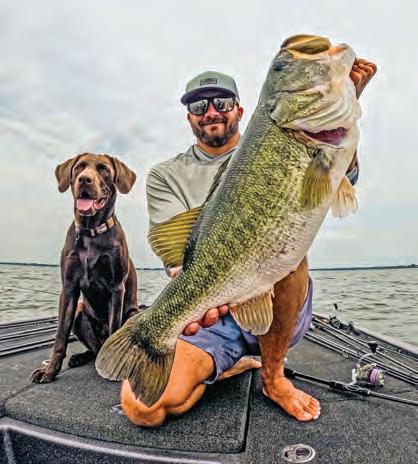
Tere are a few diferent baits I use to catch bass around these beds. Te most important thing is to stay as far away from these areas as you can, while still being able to get a cast into them. Be stealthy because shallow-water bass are skittish.
I like a bluegill-colored popping frog and also a bluegill-colored swim jig with a trailer to match. I’ll also throw a weightless wacky-rigged Senko and will put a little nail weight in the Senko when fshing deeper beds. A lightweight Carolina-rigged Trick Worm or a shallow-diving squarebill crankbait are two other good options. Hopefully this summertime bass tip helps you have a fun and productive day on your waters!
Tyler Woolcott is a professional tournament angler and guide. Check out his website at www.tylerwoolcottfshing.com.
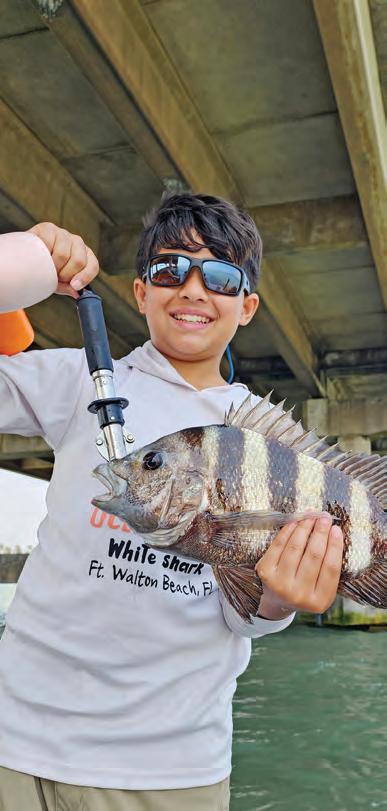
When we inshore anglers gather around the dock, you can count on one or more of these being the topic of conversation: trout, redfsh, founder or snook. Seldom is it the sheepshead. Although they are not a species frequently targeted with lures, they can provide an aggressive bite and a worthy fght. Keeping them out of the structure they love is the real challenge.
 By Capt. Michael Okruhlik
By Capt. Michael Okruhlik
depending on the current, were all it took to place his shrimp in the strike zone. Te strike zone is typically as close to the structure as possible. If you notice the sheepshead swimming around, they always have their noses to the structure.
Te sheepshead is a fsh that my son had never caught until a few weeks ago. We took a trip to South Texas to view our second of four Starship launches at the SpaceX facility. Afer the excitement and rumble of the launch, we picked up some live shrimp, and he was soon rumbling with many sheepshead.
We set our sights on the Queen Isabella Memorial Causeway, as it has a nearly unlimited amount of structure ideal for attracting sheepshead. Using the anchor mode on our trolling motor made it easy to stay close to the bridge pilings where the sheepshead were congregated. My son especially liked targeting them because we were under the causeway and in the shade, as opposed to being out on the open fats where we typically fsh.
A small sharp hook and a split-shot or two,
I fnd that keeping your bait small helps attract the bite. It is benefcial to keep a tight line, as the bites can be very light. One tactic that served my son well was to walk toward the back of the boat and away from the structure once a fsh was hooked. Tis assisted in pulling it away from the structure. Trying to manhandle the fsh out on light tackle would certainly have led to some break-ofs.
Stay vigilant in checking your line for frays afer several casts and defnitely afer each fsh. Keeping a sharp hook will also help in landing more fsh because of their boney, teeth-flled mouths. Tis turned out to be an extra memorable fshing trip. We witnessed another historic space launch, and his catch landed him in second place for the Texas CCA Star Tournament with his sheepshead.
Tis is why I always say, take a kid fshing! Tey might win a college scholarship.
Capt. Michael Okruhlik is the inventor of Knockin Tail Lures®, and the owner of www.MyCoastOutdoors.com.

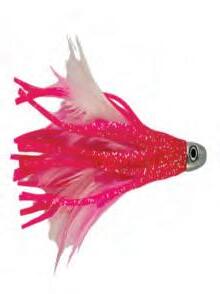
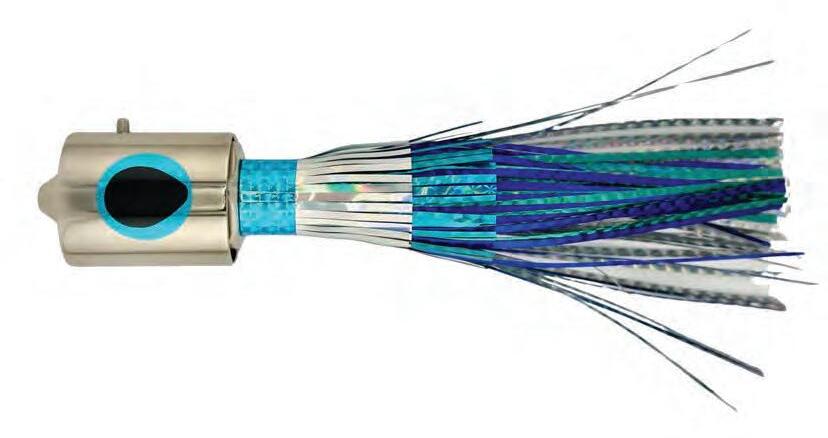

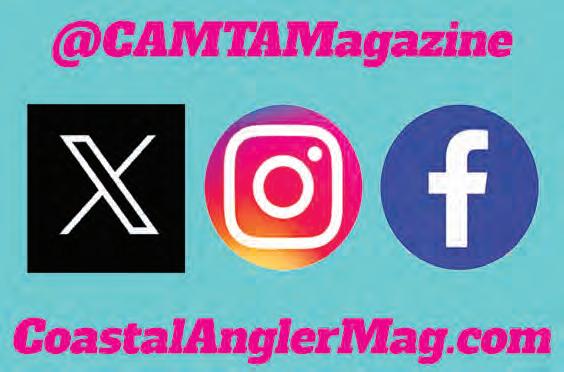
Amonster blackfn tuna caught during Te Miami Dolphins Fins Weekend tournament is an unofcial world record. Te 50.1-pound blackfn was certifed by an IGFA biologist, and it outweighs the existing IGFA all-tackle world record by a little less than three-quarters of a pound.
Angler Robert (Bob) Kowalski landed the huge blackfn aboard the 34’ Express Sportfsher Miss Britt, which was captained by Gareth Haddam and chartered by Pete Sinnick and his family. In addition to being a potential new world record, the fsh won the largest tuna division at the tournament and earned the team a $30,000 payout.

Te existing IGFA all-tackle world record blackfn tuna weighed 49 pounds, 6 ounces. It was caught in 2006 of Marathon, Florida Keys by Capt. Mathew Pullen. Fins Weekend is an annual fundraiser hosted by the Miami Dolphins. It is a two-day tournament with proceeds going to support the Baptist Health Orthopedic Institute Youth Athletic Outreach Program. For more information, go to bluewatermovements.com.















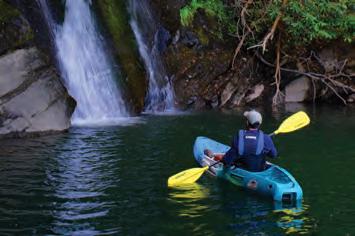

When it comes to growing giant largemouth bass, Texas has fgured some things out. Since 1986, the state’s Toyota ShareLunker program has conducted a breeding program using huge largemouths caught and donated alive by anglers. Tese donated bass, called Legacy Class, must be heavier than 13 pounds. Tey spawn in a facility before being released, along
with their ofspring, to spread big-fsh genetics across the state.
Te results of the program are apparent in the giant Texas bass caught each year. Many of them go right back into the breeding program, and the spring of 2024 was the fourth ShareLunker season in a row that the program has deemed exceptional.
Tis spring, anglers contributed 19 Legacy Class, 13-plus-pound bass from seven diferent Texas lakes. O.H. Ivie in west Texas is the best big-bass fshery in the country right now. It produced 12 bass heavier than 13 pounds this season, continuing a hot streak that goes back to the 2021.
Highlights from the 2024 Toyota ShareLunker collection season:
• Angler Kyle Hall’s 15.82-pounder was the 37th heaviest all-time Texas largemouth bass.
• Angler Kyle Hall has recorded a Legacy Lunker in three consecutive seasons.
• Six out-of-state anglers etched their name into the program’s record book. Te anglers hailed from Kansas, New York, Ohio, Oklahoma and Washington.
• Angler Larry R. Walker reeled in two Legacy Class Lunkers in 2024. State biologists did genetic analysis of this year’s Legacy Lunkers and made some incredible discoveries:
• ShareLunker 666, reeled in by Larry R. Walker from O.H. Ivie, was a recapture of ShareLunker 646 originally caught by Mechelda Criswell in 2023.
• A 13.2-pound fsh from Lake Athens was the ofspring of ShareLunker 552, which was caught by Randall E. Claybourne in 2014 at Lake Fork. Tis is the frst time a Legacy Class descendant from this family tree was discovered in the program.
• Of the 19 Legacy Class ShareLunkers, 13 had secondary relationships to either previous Legacy Class fsh or other ShareLunkers from which anglers submitted scale samples for genetic analyses.
• In the last fve years, the program has achieved an excellent overall fsh survival success rate of 94 percent.
Tat’s a lot of big-fsh genetics going back into Texas fsheries.
For more information, go to TexasSharelunker.com.



















What Stauer Clients Are Saying About Our Knives


“Outstanding knife of high quality and a great price. I now have a number of your great cutlery in my growing collection!”
— Robert F., Richardson, TX






We know you. You’re not interested in everyday, run-ofthe-mill, common cutlery. You want something with a story, a unique feature that you can brag about. We’ve got just the thing for you. Our Mighty Conifer Knife is a unique tool with a Damascus steel blade and a handle crafted from an enhanced and stabilized natural pinecone. While our competitors are charging hundreds for similar knives, we’re offering the Mighty Conifer for JUST $99! Tat’s what we call our Stauer Impossible Price.
JOIN MORE THAN
PEOPLE WHO COLLECT STAUER KNIVES
Each pinecone — and therefore, each knife — has its own unique characteristics. And the back of the handle features hand tooling, a further demonstration of each piece’s individual nature.
Te blade is nothing to scoff at either. Constructed of Damascus steel, a modern reworking of the legendary steel forged by ancient swordsmiths, this nearly 5-inch blade features 256 layers of steel that have been folded on top of each other to increase its durability. Our competitors are charging hundreds for boring, run-of-the-mill knives with no features worth bragging about. We’re asking JUST $99 for a knife unlike any you’ve seen before!
With its full-tang construction and high-quality genuine leather sheath, the Mighty Conifer Knife is the perfect blade for the




Impossible Price





person who wants to stand out. CALL NOW! If you’re one of the first 700 587 callers for this ad, we’ll throw in a pair of Stauer 8x21 Compact Binoculars — a $99 value — ABSOLUTELY FREE! Satisfaction guaranteed or your money back!
Knife Specifcations:
• 9 ½" overall length. Full-tang construction
• Damascus steel blade and natural pinecone handle
• Genuine leather sheath
Mighty Conifer Knife


EXCLUSIVE FREE
Stauer 8x21 Compact Binoculars a $99 value with your purchase






$299 $99* + S&P Save $200
*You must use Insider Offer Code: MCK186-01 to get this price. California residents please call regarding Proposition 65 regulations before purchasing this product.
1-800-333-2045
Your Insider Offer Code: MCK186-01




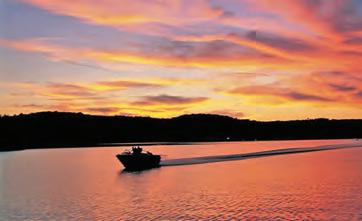


With more than 60,000 surface acres and 1,300 miles of shoreline, Grand Lake O’ the Cherokees is one of the largest outdoor destinations in Oklahoma. Located on the Grand River, the lake is hugely popular with boaters, fishermen, campers and anyone else who loves spending time in the great outdoors. Anglers are sure to have a blast searching for largemouth bass, white bass, crappie, channel catfish, bluegill and the rare paddlefish on Grand Lake waters. And Grand Lake’s shores are lined with so many unique attractions, shops, restaurants, state parks and casinos that seeing everything in one trip is next to impossible. There’s truly something for everyone to love in the Grand Lake Area!

Discover all the fun things to see and do in the Grand Lake Area as well as places to stay, places to eat, festivals and more at GrandLakeFun.com


